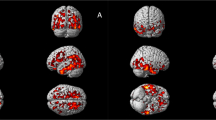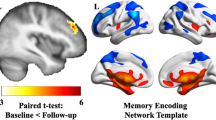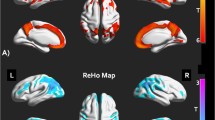Abstract
In preclinical Alzheimer’s disease, neuro-functional changes due to amyloid-β (Aβ) deposition are not synchronized in different brain lobes and subcortical nuclei. This study aimed to explore the correlation between brain Aβ burden, connectivity changes in an ultra-large structural scale, and cognitive function in mild cognitive impairment. Participants with mild cognitive impairment were recruited and underwent florbetapir (F18-AV45) PET, resting-state functional MRI, and multidomain neuropsychological tests. AV-45 standardized uptake value ratio (SUVR) and functional connectivity of all participants were calculated. Of the total 144 participants, 72 were put in the low Aβ burden group and 72 in the high Aβ burden group. In the low Aβ burden group, all connectivities between lobes and nuclei had no correlation with SUVR. In the high Aβ burden group, SUVR showed negative correlations with the Subcortical-Occipital connectivity (r=-0.36, P = 0.02) and Subcortical-Parietal connectivity (r=-0.26, P = 0.026). Meanwhile, in the high Aβ burden group, SUVR showed positive correlations with the Temporal-Prefrontal connectivity (r = 0.27, P = 0.023), Temporal-Occipital connectivity (r = 0.24, P = 0.038), and Temporal-Parietal connectivity (r = 0.32, P = 0.006). Subcortical to Occipital and Parietal connectivities had positive correlations with general cognition, language, memory, and executive function. Temporal to Prefrontal, Occipital, and Parietal connectivities had negative correlations with memory function, executive function, and visuospatial function, and a positive correlation with language function. In conclusion, Individuals with mild cognitive impairment with high Aβ burden have Aβ-related bidirectional functional connectivity changes between lobes and subcortical nuclei that are associated with cognitive decline in multiple domains. These connectivity changes reflect neurological impairment and failed compensation.


Similar content being viewed by others
Data Availability
Study data are available on request to the authors.
References
Adamczuk, K., Schaeverbeke, J., Nelissen, N., Neyens, V., Vandenbulcke, M., Goffin, K., et al. (2016). Amyloid imaging in cognitively normal older adults: Comparison between (18)F-flutemetamol and (11)C-Pittsburgh compound B. European Journal of Nuclear Medicine and Molecular Imaging, 43(1), 142–151. https://doi.org/10.1007/s00259-015-3156-9.
Arendt, T., Brückner, M. K., Morawski, M., Jäger, C., & Gertz, H. J. (2015). Early neurone loss in Alzheimer’s disease: Cortical or subcortical? Acta Neuropathologica Communications, 3, 10. https://doi.org/10.1186/s40478-015-0187-1.
Bai, F., Zhang, Z., Watson, D. R., Yu, H., Shi, Y., Yuan, Y., et al. (2009). Abnormal functional connectivity of hippocampus during episodic memory retrieval processing network in amnestic mild cognitive impairment. Biological Psychiatry, 65(11), 951–958. https://doi.org/10.1016/j.biopsych.2008.10.017.
Bai, F., Liao, W., Watson, D. R., Shi, Y., Wang, Y., Yue, C., et al. (2011). Abnormal whole-brain functional connection in amnestic mild cognitive impairment patients. Behavioural Brain Research, 216(2), 666–672. https://doi.org/10.1016/j.bbr.2010.09.010.
Bateman, R. J., Xiong, C., Benzinger, T. L. S., Fagan, A. M., Goate, A., Fox, N. C., et al. (2012). Clinical and biomarker changes in dominantly inherited Alzheimer’s disease. The New England Journal of Medicine, 367(9), 795–804. https://doi.org/10.1056/NEJMoa1202753.
Berron, D., van Westen, D., Ossenkoppele, R., Strandberg, O., & Hansson, O. (2020). Medial temporal lobe connectivity and its associations with cognition in early Alzheimer’s disease. Brain: A Journal of Neurology, 143(4), 1233–1248. https://doi.org/10.1093/brain/awaa068.
Bondi, M. W., Edmonds, E. C., Jak, A. J., Clark, L. R., Delano-Wood, L., McDonald, C. R., et al. (2014). Neuropsychological criteria for mild cognitive impairment improves diagnostic precision, biomarker associations, and progression rates. Journal of Alzheimer’s disease: JAD, 42(1), 275–289. https://doi.org/10.3233/JAD-140276.
Buckley, R. F., Schultz, A. P., Hedden, T., Papp, K. V., Hanseeuw, B. J., Marshall, G., et al. (2017). Functional network integrity presages cognitive decline in preclinical Alzheimer disease. Neurology, 89(1), 29–37. https://doi.org/10.1212/WNL.0000000000004059.
Chhatwal, J. P., Schultz, A. P., Johnson, K. A., Hedden, T., Jaimes, S., Benzinger, T. L. S., et al. (2018). Preferential degradation of cognitive networks differentiates Alzheimer’s disease from ageing. Brain: A Journal of Neurology, 141(5), 1486–1500. https://doi.org/10.1093/brain/awy053.
Chong, J. S. X., Jang, H., Kim, H. J., Ng, K. K., Na, D. L., Lee, J. H., et al. (2019). Amyloid and cerebrovascular burden divergently influence brain functional network changes over time. Neurology, 93(16), e1514–e1525. https://doi.org/10.1212/WNL.0000000000008315.
Cui, L., Zhang, Z., Zac Lo, C. Y., & Guo, Q. (2021). Local functional MR Change Pattern and its Association with cognitive function in objectively-defined subtle cognitive decline. Frontiers in Aging Neuroscience, 13, 684918. https://doi.org/10.3389/fnagi.2021.684918.
Dautricourt, S., de Flores, R., Landeau, B., Poisnel, G., Vanhoutte, M., Delcroix, N., et al. (2021). Longitudinal changes in hippocampal network connectivity in Alzheimer’s Disease. Annals of Neurology, 90(3), 391–406. https://doi.org/10.1002/ana.26168.
Favaretto, C., Allegra, M., Deco, G., Metcalf, N. V., Griffis, J. C., Shulman, G. L., et al. (2022). Subcortical-cortical dynamical states of the human brain and their breakdown in stroke. Nature Communications, 13(1), 5069. https://doi.org/10.1038/s41467-022-32304-1.
Filippi, M., Basaia, S., Canu, E., Imperiale, F., Meani, A., Caso, F., et al. (2017). Brain network connectivity differs in early-onset neurodegenerative dementia. Neurology, 89(17), 1764–1772. https://doi.org/10.1212/WNL.0000000000004577.
Fischer, F. U., Wolf, D., & Fellgiebel, A. (2019). Connectivity and morphology of hubs of the cerebral structural connectome are associated with brain resilience in AD- and age-related pathology. Brain Imaging and Behavior, 13(6), 1650–1664. https://doi.org/10.1007/s11682-019-00090-y. & Alzheimer’s Disease Neuroimaging Initiative*
Franzmeier, N., Düzel, E., Jessen, F., Buerger, K., Levin, J., Duering, M., et al. (2018). Left frontal hub connectivity delays cognitive impairment in autosomal-dominant and sporadic Alzheimer’s disease. Brain: A Journal of Neurology, 141(4), 1186–1200. https://doi.org/10.1093/brain/awy008.
Gordon, B. A., Blazey, T. M., Su, Y., Hari-Raj, A., Dincer, A., Flores, S., et al. (2018). Spatial patterns of neuroimaging biomarker change in individuals from families with autosomal dominant Alzheimer’s disease: A longitudinal study. The Lancet Neurology, 17(3), 241–250. https://doi.org/10.1016/S1474-4422(18)30028-0.
Guzmán-Vélez, E., Diez, I., Schoemaker, D., Pardilla-Delgado, E., Vila-Castelar, C., Fox-Fuller, J. T., et al. (2022). Amyloid-β and tau pathologies relate to distinctive brain dysconnectomics in preclinical autosomal-dominant Alzheimer’s disease. Proceedings of the National Academy of Sciences of the United States of America, 119(15), e2113641119. https://doi.org/10.1073/pnas.2113641119.
Habib, M., Mak, E., Gabel, S., Su, L., Williams, G., Waldman, A., et al. (2017). Functional neuroimaging findings in healthy middle-aged adults at risk of Alzheimer’s disease. Ageing Research Reviews, 36, 88–104. https://doi.org/10.1016/j.arr.2017.03.004.
Hansson, O. (2021). Biomarkers for neurodegenerative diseases. Nature Medicine, 27(6), 954–963. https://doi.org/10.1038/s41591-021-01382-x.
Harrison, O. K., Guell, X., Klein-Flügge, M. C., & Barry, R. L. (2021). Structural and resting state functional connectivity beyond the cortex. Neuroimage, 240, 118379. https://doi.org/10.1016/j.neuroimage.2021.118379.
Horien, C., Greene, A. S., Constable, R. T., & Scheinost, D. (2020). Regions and connections: Complementary approaches to characterize Brain Organization and function. The Neuroscientist: A Review Journal Bringing Neurobiology Neurology and Psychiatry, 26(2), 117–133. https://doi.org/10.1177/1073858419860115.
Huang, L., Chen, K., Liu, Z., & Guo, Q. (2020). A conceptual Framework for Research on Cognitive Impairment with no dementia in memory clinic. Current Alzheimer Research, 17(6), 517–525. https://doi.org/10.2174/1567205017666200807193253.
Jack, C. R., Lowe, V. J., Weigand, S. D., Wiste, H. J., Senjem, M. L., Knopman, D. S., et al. (2009). Serial PIB and MRI in normal, mild cognitive impairment and Alzheimer’s disease: Implications for sequence of pathological events in Alzheimer’s disease. Brain: A Journal of Neurology, 132(Pt 5), 1355–1365. https://doi.org/10.1093/brain/awp062.
Jagust, W. (2018). Imaging the evolution and pathophysiology of Alzheimer disease. Nature Reviews Neuroscience, 19(11), 687–700. https://doi.org/10.1038/s41583-018-0067-3.
Karran, E., & De Strooper, B. (2022). The amyloid hypothesis in Alzheimer disease: New insights from new therapeutics. Nature Reviews Drug Discovery, 21(4), 306–318. https://doi.org/10.1038/s41573-022-00391-w.
Levin, F., Jelistratova, I., Betthauser, T. J., Okonkwo, O., Johnson, S. C., Teipel, S. J., & Grothe, M. J. (2021). In vivo staging of regional amyloid progression in healthy middle-aged to older people at risk of Alzheimer’s disease. Alzheimer’s Research & Therapy, 13(1), 178. https://doi.org/10.1186/s13195-021-00918-0.
Luo, X., Li, K., Zeng, Q., Huang, P., Jiaerken, Y., Qiu, T., et al. (2018). Decreased bilateral FDG-PET uptake and inter-hemispheric connectivity in Multi-Domain Amnestic mild cognitive impairment patients: A preliminary study. Frontiers in Aging Neuroscience, 10, 161. https://doi.org/10.3389/fnagi.2018.00161.
Luo, J., Agboola, F., Grant, E., Masters, C. L., Albert, M. S., Johnson, S. C., et al. (2020). Sequence of Alzheimer disease biomarker changes in cognitively normal adults: A cross-sectional study. Neurology, 95(23), e3104–e3116. https://doi.org/10.1212/WNL.0000000000010747.
Mattsson, N., Palmqvist, S., Stomrud, E., Vogel, J., & Hansson, O. (2019). Staging β -Amyloid Pathology with amyloid Positron Emission Tomography. JAMA Neurology, 76(11), 1319. https://doi.org/10.1001/jamaneurol.2019.2214.
Murray, M. E., Lowe, V. J., Graff-Radford, N. R., Liesinger, A. M., Cannon, A., Przybelski, S. A., et al. (2015). Clinicopathologic and 11 C-Pittsburgh compound B implications of Thal amyloid phase across the Alzheimer’s disease spectrum. Brain: A Journal of Neurology, 138(Pt 5), 1370–1381. https://doi.org/10.1093/brain/awv050.
Neitzel, J., Franzmeier, N., Rubinski, A., Ewers, M., & Alzheimer’s Disease Neuroimaging Initiative (ADNI). (2019). Left frontal connectivity attenuates the adverse effect of entorhinal tau pathology on memory. Neurology, 93(4), e347–e357. https://doi.org/10.1212/WNL.0000000000007822.
Oh, H., & Jagust, W. J. (2013). Frontotemporal network connectivity during memory encoding is increased with aging and disrupted by beta-amyloid. The Journal of Neuroscience: The Official Journal of the Society for Neuroscience, 33(47), 18425–18437. https://doi.org/10.1523/JNEUROSCI.2775-13.2013.
Palta, P., Rippon, B., Reitz, C., He, H., Sherwood, G., Ceballos, F., et al. (2020). Apolipoprotein E genotype and in vivo amyloid burden in middle-aged Hispanics. Neurology, 95(15), e2086–e2094. https://doi.org/10.1212/WNL.0000000000010707.
Pievani, M., de Haan, W., Wu, T., Seeley, W. W., & Frisoni, G. B. (2011). Functional network disruption in the degenerative dementias. The Lancet Neurology, 10(9), 829–843. https://doi.org/10.1016/S1474-4422(11)70158-2.
Pini, L., Wennberg, A. M., Salvalaggio, A., Vallesi, A., Pievani, M., & Corbetta, M. (2021). Breakdown of specific functional brain networks in clinical variants of Alzheimer’s disease. Ageing Research Reviews, 72, 101482. https://doi.org/10.1016/j.arr.2021.101482.
Ps, Z. S., et al. (2015). Brain amyloid-β burden is associated with disruption of intrinsic functional connectivity within the medial temporal lobe in cognitively normal elderly. The Journal of neuroscience: the official journal of the Society for Neuroscience, 35(7), https://doi.org/10.1523/JNEUROSCI.2092-14.2015.
Qi, Z., Wu, X., Wang, Z., Zhang, N., Dong, H., Yao, L., & Li, K. (2010). Impairment and compensation coexist in amnestic MCI default mode network. Neuroimage, 50(1), 48–55. https://doi.org/10.1016/j.neuroimage.2009.12.025.
Stratmann, K., Heinsen, H., Korf, H. W., Del Turco, D., Ghebremedhin, E., Seidel, K., et al. (2016). Precortical Phase of Alzheimer’s Disease (AD)-Related tau Cytoskeletal Pathology. Brain Pathology (Zurich Switzerland), 26(3), 371–386. https://doi.org/10.1111/bpa.12289.
Thal, D. R., Rüb, U., Orantes, M., & Braak, H. (2002). Phases of a beta-deposition in the human brain and its relevance for the development of AD. Neurology, 58(12), 1791–1800. https://doi.org/10.1212/wnl.58.12.1791.
Thal, D., Rudolf, Beach, T. G., Zanette, M., Heurling, K., Chakrabarty, A., Ismail, A., et al. (2015a). [(18) F]flutemetamol amyloid positron emission tomography in preclinical and symptomatic Alzheimer’s disease: Specific detection of advanced phases of amyloid-β pathology. Alzheimer’s & Dementia: The Journal of the Alzheimer’s Association, 11(8), 975–985. https://doi.org/10.1016/j.jalz.2015a.05.018.
Thal, D., Rudolf, Walter, J., Saido, T. C., & Fändrich, M. (2015b). Neuropathology and biochemistry of Aβ and its aggregates in Alzheimer’s disease. Acta Neuropathologica, 129(2), 167–182. https://doi.org/10.1007/s00401-014-1375-y.
Tosun, D., Demir, Z., Veitch, D. P., Weintraub, D., Aisen, P., Jack, C. R., et al. (2022). Contribution of Alzheimer’s biomarkers and risk factors to cognitive impairment and decline across the Alzheimer’s disease continuum. Alzheimer’s & Dementia: The Journal of the Alzheimer’s Association, 18(7), 1370–1382. https://doi.org/10.1002/alz.12480.
Tzourio-Mazoyer, N., Landeau, B., Papathanassiou, D., Crivello, F., Etard, O., Delcroix, N., et al. (2002). Automated anatomical labeling of activations in SPM using a macroscopic anatomical parcellation of the MNI MRI single-subject brain. Neuroimage, 15(1), 273–289. https://doi.org/10.1006/nimg.2001.0978.
Veitch, D. P., Weiner, M. W., Aisen, P. S., Beckett, L. A., Cairns, N. J., Green, R. C. (2019). Understanding disease progression and improving Alzheimer’s disease clinical trials: Recent highlights from the Alzheimer’s Disease Neuroimaging Initiative. Alzheimer’s & Dementia: The Journal of the Alzheimer’s Association, 15(1), 106–152. https://doi.org/10.1016/j.jalz.2018.08.005
Wang, K., Liang, M., Wang, L., Tian, L., Zhang, X., Li, K., & Jiang, T. (2007). Altered functional connectivity in early Alzheimer’s disease: A resting-state fMRI study. Human Brain Mapping, 28(10), 967–978. https://doi.org/10.1002/hbm.20324.
Xu, W., Rao, J., Song, Y., Chen, S., Xue, C., Hu, G., et al. (2021). Altered functional connectivity of the basal nucleus of meynert in subjective cognitive impairment, early mild cognitive impairment, and late mild cognitive impairment. Frontiers in Aging Neuroscience, 13, 671351. https://doi.org/10.3389/fnagi.2021.671351.
Zhang, Z., Cui, L., Huang, Y., Chen, Y., Li, Y., & Guo, Q. (2021). Changes of Regional neural activity homogeneity in preclinical Alzheimer’s Disease: Compensation and dysfunction. Frontiers in Neuroscience, 15, 646414. https://doi.org/10.3389/fnins.2021.646414.
Acknowledgements
We would like to thank Jie-Hua Zhu, Yi-Fan Wang, Xian-Qing Xie, and Yun Yang for their help with neuropsychological tests.
Funding
This work was supported by the National Natural Science Foundation of China (82171198); Shanghai Municipal Science Technology Major Project (2018SHZDZX01); Guangdong Provincial Key S&T Program (2018B030336001); Innovation and Technology Commission of Hong Kong Project (MRP 042/18X); Shanghai Municipal Health Commission (202140042).
Author information
Authors and Affiliations
Contributions
Concept and design: Liang Cui, Zhen Zhang, Qi-Hao Guo. Drafting of the manuscript: Liang Cui. Critical revision of the manuscript for important intellectual content: Yi-Han Guo, Jie-Hui Jiang, Qi-Hao Guo. Statistical analysis: Liang Cui, Qi-Hao Guo. Obtained funding: Liang Cui, Qi-Hao Guo. Administrative, technical, or material support: Zhen Zhang, Yan-Lu Huang, Yi-Hui Guan, Chun-Yi Zac Lo, Fang Xie, Jie-Hui Jiang. Supervision: Jie-Hui Jiang, Qi-Hao Guo. All authors reviewed the manuscript.
Corresponding authors
Ethics declarations
Competing interests
The authors declare no competing interests.
Ethical Approval
The study was reviewed and approved by the ethics committee (approval number 2019-041) and performed in accordance with the principles of the Declaration of Helsinki. The participants provided their written informed consent to participate in this study.
Informed consent
Informed consent was obtained from all individual participants included in the study.
Additional information
Publisher’s Note
Springer Nature remains neutral with regard to jurisdictional claims in published maps and institutional affiliations.
Liang Cui and Zhen Zhang contributed equally to this work.
Electronic supplementary material
Below is the link to the electronic supplementary material.
Rights and permissions
Springer Nature or its licensor (e.g. a society or other partner) holds exclusive rights to this article under a publishing agreement with the author(s) or other rightsholder(s); author self-archiving of the accepted manuscript version of this article is solely governed by the terms of such publishing agreement and applicable law.
About this article
Cite this article
Cui, L., Zhang, Z., Huang, YL. et al. Brain amyloid-β deposition associated functional connectivity changes of ultra-large structural scale in mild cognitive impairment. Brain Imaging and Behavior 17, 494–506 (2023). https://doi.org/10.1007/s11682-023-00780-8
Accepted:
Published:
Issue Date:
DOI: https://doi.org/10.1007/s11682-023-00780-8




